CES 2021 – A Virtual Walk Around
[January 2021] The annual International CES in Las Vegas is the place to see what is new in the electronics industry. At least it usually is the place.
As with so many conventions and shows, the 2021 International CES was actually a virtual show.
This approach had several benefits. It really was a very personal convention. For your friendly Editor, it meant I did not have to walk more than five miles a day, ending up with feet that simply refused to go further! Furthermore, the way the virtual setup was done, getting information and data sheets was made easier, both from the standpoint of finding the companies (if they were there) and using zoom to get personal contact and answers.
On the other hand, as almost all of us know, the downside is that with unending Zoom connections it is easy to spend the whole day jumping from one news conference to a virtual booth and repeat, until it is hard to remember to whom you spoke – or even, at times, your own name.
With that in mind, let me share some of what I learned this year.
Base Stats
Usually CES draws about 4000 exhibitors to the millions of square feet of displays. This year, the Las Vegas Convention Center was empty … really empty. I would share a picture, but it would have nothing in it … totally empty.
Almost 2000 companies – 1300 from outside the US – launched products during this first ever, all-digital CES 2021, including almost 700 startups from 37 countries. One thing they liked, it cost as little as $1200 to set up a virtual booth – no hotel or food costs, etc. Even so, many companies were not visible, choosing direct email, direct press releases, etc. to get their word out.
Attendees joined from over 150 countries. The exact number was not given. But based on some of the Zoom meetings, it was substantial. Many did comment that their feet were much happier than usual.
Pandemic Driven Choices
Not only the mode of the Show, but the contents were very much driven by the times in which we are living.
Yes, there were many products related to the pandemic and/or lockdowns. From “smart masks” to a doorbell that scans for fever in of visitors. Or, how about an air quality monitor, an air purifier, or a UV unit to disinfect studios, even microphone windscreens – some even set up like those robots that wander around the room vacuuming these new products “walk” around sanitizing.
To give you one idea: a single Clean Air Zone unit is designed to clean from 700-1200 square feet, at around $1,495.
Something to Watch
One of the first things people did in the lockdown was upgrade their TVs. According to the Consumer Technology Association (CTA), strong demand will continue through 2021. The industry expects 55-inch and greater TVs to have the greatest growth; subscriptions to online video streamers continue strong.
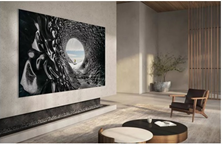
Right on cue, a 110 inch micro LED TV was being shown by Samsung, for only $110k.
With its interlocking set of smaller screens, it can look like a painting on the wall or show four video sources at once.
The 55-inch LG screen is rollable, retracting into a headboard, etc. Other new features coming to your TV before long include LG’s 48-inch gaming or viewing screen – it is bendable for best vision. Or, perhaps you would one of several screens special designed for video conferencing.
At the top end, Sony’s Video Wall, designed for producing programs and movies sells for something over $1 Million a screen … with over 100 sold into the industry so far.
All of which leads us to ATSC3.
ATSC3
During 2020, the two biggest stories in the TV industry was the continued build-out of ATSC3 signals, and the $80 Billion C-Band Auction to feed 5G demands.
ATSC3 is now available in 25 markets with LA and San Antonio the next to come on line. The target is first to reach 62 markets with 75% of all viewers in the US. Quite a few models of TVs were shown, both with 4k and 8k features, as were new converter boxes. (If you are looking for a converter box, be sure it is ATSC3, as a lot of the older ATSC1 boxes are still out there.)
As most know, ATSC3 allows a TV station to combine digital channels with Internet streaming. The 5G services are seeking to exploit the ability to run many different video and audio channels. And while 4k is the new level, in less than 5 years, the industry expects 8k to take over.
5G Is On Line
As the $80 Million+ C-Band Auction has concluded, the rush to build out more 5G capacity is next.
According to reports, 5G is now reaching over 200 Million people in 1,800 cities and towns – and is being adopted by business and industry around the world.
Bringing it to users, Verizon’s 5G Ultra-Wideband alone thinks it will reach an estimated 55 Billion devices by 2025. Verizon also started a millimeter-wave $50 home service which should provide download speeds of 300 Mbps. The network also is being installed in 28 NFL stadiums this year, with plans to use the locations for real-time, on-site multiplayer game venues.
Enough Bandwidth?
Speaking of 5G, some folks think it is coming at just the right time.
Before the pandemic, smart speakers and impressive screens were the biggest sellers. Now, with more people at home working, attending meetings and school, 2020 became a record year for the sale of laptops, tablets, and other portable devices. (Many families now sport three, four, five, or more portable devices.)
HP has an impressive convertible, the Elite Dragonfly Max.
Meanwhile, Asus remembers all those people who like to work on two screens with a laptop that has a second screen above the keyboard. It can be used separately or combined with the main screen.
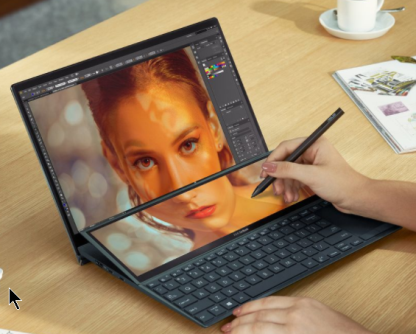
With multiple users stressing systems, a new group of Wi-Fi 6 routers is not just faster but also more efficient at sharing bandwidth across to all of your home devices. Netgear Nighthawk RAXE500 Wi-Fi 6e is worth a look; it will handle up to 12 separate streams. Meanwhile, Linksys’ new mesh unit can cover up to 3,000 sq. ft. with WiFi 6E. Additionally, there are units that are specifically designed for gaming use.
Audio For the Ears
As with the move to bigger TVs, the audio industry has definitely been the source of many more premium products. Most audio product categories have developed a premium range as well as a budget range.
Covid-19 has helped these premium audio products to thrive. After all, getting good quality audio in the home has never been more important, as people watch movies and streaming video at home. Despite some soundbar models more than $1k, sales grew by a third early in 2020.
Among the pleasures at previous CESs were the numerous suites at the Venetian, where you could hear some really lovely speakers. Of course, the price tags were a bit more than the typical JBL or Klipsch speakers usually found in decent studio installations.
In Your Ear
Earbuds got quite a series of upgrades this year, although I am a bit ambivalent about having them seem to hang down out of my ear. Others are designed to really fit the hearing canal, providing isolation for noisy environments.
Still others in the “hearable” category have focused on higher audio quality, Active Noise Cancellation (ANC), and tailored EQ for slight to moderate hearing loss. Compatibility to laptops and tablets have become must-have features.
In fact, a few of the newest models are even taking advantage of recent FDA rulings that let them start to invade the Hearing Aid category. The industry expects 60% growth in hearables this year.
Nuheara’s IQbuds2 MAX are not presenting themselves as hearing aids.
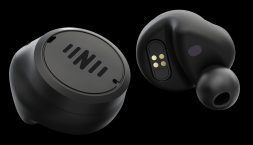
But for a fraction of a traditional hearing aid, you get an app that helps set up crisp Bluetooth audio tailored to your ears, ANC, pairing to your phone, and the app to adjust the audio for different situations.
The IQbuds2 MAX even come with a full selection of ear tips, allowing you to get a good fit for almost any ear comfortably.
Another approach is Aftershokz new OpenComm headset.

Aftershokz are well known for their bone conduction headsets, allowing you to hear audio clearly without blocking your ears. Even many with significant hearing loss can hear clearly via the bone conduction.
The new OpenComm model adds a microphone boom, ANC, and 16 hours of talk time. Listening to music or talking on the phone all day long? Just five minutes of charging will let you run for another two hours.
Dare I also mention some of the newer headphone models like the Apple AirPods Pro, AirPods Max or the Sony WH-1000XM series? They and others have brought higher audio quality to the mass-market – and rather higher than usual prices (well over $500, for example).
And Round and Round
We do not want to forget turntables, especially with vinyl becoming more popular of late.
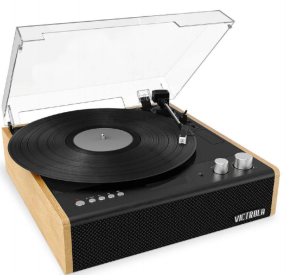 An interesting exhibitor with a familiar name, Victrola, isplayed a new modestly priced turntable – the Eastwood – that, using an Audio Technica cartridge and built-in preamp and speakers, handles 33/45/78 records with what looks like fairly acceptable way to audition discs new and old. Other models are available with many retro looking designs.
An interesting exhibitor with a familiar name, Victrola, isplayed a new modestly priced turntable – the Eastwood – that, using an Audio Technica cartridge and built-in preamp and speakers, handles 33/45/78 records with what looks like fairly acceptable way to audition discs new and old. Other models are available with many retro looking designs.
Audio Technica itself boasts a nice range of turntables from $99 to $800 … including direct drive models with speed adjustments. The new AT-LP120XBT-USB does analog, wireless, and USB outputs. But, sure, with some other manufacturers you can easily spend $20k or more on a ultra high-end turntable setup. And reports suggest that sales of $5,000+ turntables will increase 15% a year.
The IOT Builds Out
The Internet of Things definitely gets a bit more and more “complex and complete” each year.
This second (or third) generation brings a whole group of new features to market, with many companies offering whole lines of health and wellness products and applications to control your exercise/activities, food intake, and health/body monitoring, with readouts on your smartphone.
With so many working from home, the “smart home” products have become much more common; within three years it is estimated that one-half of US homes will have everything from smart meters to measure electricity, gas, water, etc, to motion driven security cameras watching the house and neighborhood.
What is in store, if the products shown are the examples? More voice assistants, with AI becoming much more StarTrekkie, and controlling everything from entertainment devices to the home environment itself. Would you like a bathtub that monitors the water temperature, your heart beats, adds light, fog, essential oils aroma, and soothing sounds? It is coming; the current price is only $16k.
Danger, Will Robinson!
Many people see the letters AI, or connections through a speaker assistant, and instantly realize that under all of those features and convenience of the “smart home” is data collection. This is, in fact, the primary thing holding back greater adoption of IoT devices; customers think there is already too much data collection and spying on their lives.
Have you ever been frustrated by looking at a page on the Internet and literally a dozen or more ads fight with the content for your screen space and attention?
The largest companies want you to believe it is all benign, but news of site data breeches and reports of data being sold on the Dark Web lead many to consider what information is available (a lot) and what individuals can do about it (not so much) other than ensure their passwords are as secure as possible.
Given that, software and hardware solutions to keep data safe continue to proliferate. From programs that “freeze” files, preventing ransomware from encrypting or overwriting them to backup solutions using the “cloud” to isolate files in case of malware, every home and company have options to keep the most important parts of their life secure.
One solution is to have a small, portable solid state drive (SSD) and carry everything important with you.

BIWINTECH, a company that has been making memory for large companies, including HP, for 25 years, this year is bringing to market memory products under their own brand. Among the products, is an SSD that will fit in the palm of your hand with capacities from 256 GB to a full Terabyte.
The SelfSafe ID Bracelet is another way to keep your key data close, but not on line.
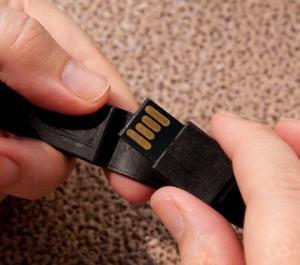
This password protected waterproof USB emergency bracelet stores all your important personal data, including personal identification, medical, financial, insurance, travel documents, etc. You can lose your wallet, ID, even your home (in a disaster), and yet anything you need to carry on is right there. At less than $30, this is something you may wish to use as a gift to family and friends.
Still, data collection will likely continue so long as there is profit potential. Will the next generation be more successful in keeping their privacy? That is a question that is hard to answer – especially when you see all the things that add every year to the IoT.
Power Considerations
Naturally, all those devices need power. Sometimes, it sort of looks like a litter of pups vying for their mother’s milk.
Charging hubs, wireless chargers, and special cables all play into what we need for the pile of devices we have on hand. Since, pandemic times aside, we are often on the move, having the right cable at the right time is not always easy. Several companies have focused on producing cables that will withstand life on the bench and on the road.
Tough Tested is one brand that has a line of durable, braided Armor Flex cables and audio cords worth checking out. Several Tough Tested models combine power banks that have solar panels to recharge themselves when you are out in the field all day – from 10,000 to 24,000 mAh in about the size of your smartphone. They have four features that make it handier than most power banks: it will charge your phone wirelessly (Q1), it has a solar panel so that if you are out all day, the power bank can even recharge itself from the Sun, it has an LED flashlight, and two USB and one USB-C ports.
Smart Phone Sale Pricing
The most recent iteration of smart phones seems to have gotten cheaper, with a few exceptions. Maybe it is the pandemic, but smart phone sales were down this year. Nevertheless, all the major players brought out newer models. What can they add to get you to buy a new phone?
Of course, you start with 5G compatibility, but for most people 5G speed is not the key, usability is. So LG has a smart phone with a rollable screen that quickly becomes tablet sized. Foldable suddenly is passé.

Whether you opt for “bigger is better” or stay with your standard size smart phone, you like mutter nasty things when trying to type a note or enter a phone number. An app displayed by Typewise enlarges your keyboard to make things a lot easier.
Of course, the greater challenge is how we now use our smartphones for everything – starting/locking the car(s), home security, system monitoring/tracking, banking/payments, texting and … oh yes, occasionally making a call. Yes, there is a lot of valuable personal information in one device. More importantly, there is a lot of really different, really unique, really easy to forget passwords!
Car Talk
Among the places to see the latest and greatest, there were a lot of electric vehicles of various sizes (literally dozens), and most feature AI operation or assistance of one sort or another.
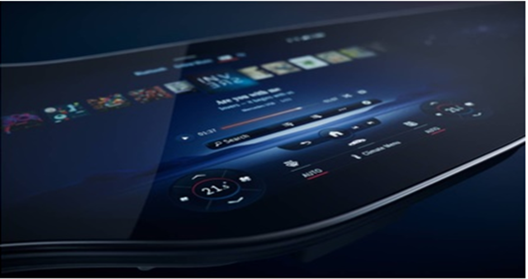
BMW even displayed a model with a complete 56-inch pillar-to-pillar curved Hyperscreen – a touch screen, voice control, and eye-tracking technology to follow the driver’s gaze!
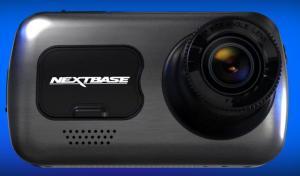 Among all the AI and digital information products is one that can really be a boon to anyone on the road – and especially to those that go to remote transmitter sites. While DashCams have been around for a few years, there are models now available with features that not only show traffic or record road accidents but are useful for site security and road conditions, can utilize both GPS and Three-Word location with 4k video (displayed either on a large 3-inch touch screen – or your TV!), image stabilization and slow motion to make insurance claims easier, and front and rear views simultaneously, and interact with Alexa. A couple of the models that especially caught my eye came from NextBase a firm that has really thought out making a DashCam as flexible as you could want.
Among all the AI and digital information products is one that can really be a boon to anyone on the road – and especially to those that go to remote transmitter sites. While DashCams have been around for a few years, there are models now available with features that not only show traffic or record road accidents but are useful for site security and road conditions, can utilize both GPS and Three-Word location with 4k video (displayed either on a large 3-inch touch screen – or your TV!), image stabilization and slow motion to make insurance claims easier, and front and rear views simultaneously, and interact with Alexa. A couple of the models that especially caught my eye came from NextBase a firm that has really thought out making a DashCam as flexible as you could want.
A Toy Store For Adults
There are so many other items to comment on, and we will try to bring those to you as the year progresses, but for many the CES is the adult toy store. And in that spirit, here are two that you would probably want to grab, if you could.
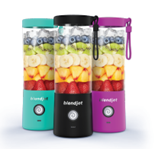
First, the BlendJet2, a portable, rechargeable blender, that you can take to the office or out in the field to quickly make smoothies or your favorite adult beverage. Able to do up to 15 blends on one charge, this may make healthier drinks easier for those of us trying to whip up something better for us than a cup of cola.
Now, the big dream: the Keurig ColdSnap ice cream maker.
Using single serve pods, the ColdSnap can produce your choice of soft-serve ice cream, protein shakes, coffees, smoothies, and more – in about 90 seconds.

While you may be salivating, you have to know the current price is about $1000, although Keurig says they want to cut that in half. Right, you now want two!
We hope you will feel this has been a good look at some of the high points from CES. There are still other products worth comment, and as we see which ones actually come to market, we will share more information.
